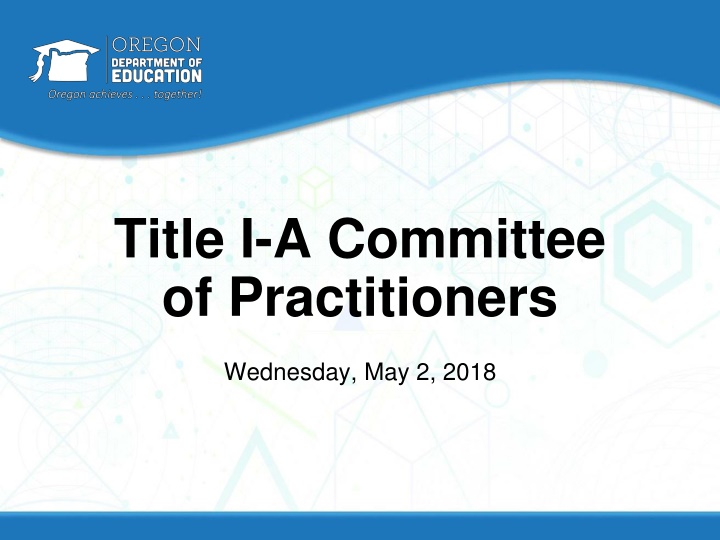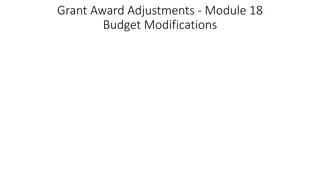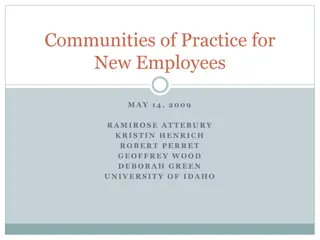
Title I-A Committee of Practitioners Meeting Highlights
Explore the recent Title I-A Committee of Practitioners meeting featuring agenda items on bylaws, Title IV-A grants, and guest presenters discussing student support and academic achievement. Learn about the focus on well-rounded education, technology use, and other key initiatives in education.
Download Presentation

Please find below an Image/Link to download the presentation.
The content on the website is provided AS IS for your information and personal use only. It may not be sold, licensed, or shared on other websites without obtaining consent from the author. If you encounter any issues during the download, it is possible that the publisher has removed the file from their server.
You are allowed to download the files provided on this website for personal or commercial use, subject to the condition that they are used lawfully. All files are the property of their respective owners.
The content on the website is provided AS IS for your information and personal use only. It may not be sold, licensed, or shared on other websites without obtaining consent from the author.
E N D
Presentation Transcript
Title I-A Committee of Practitioners Wednesday, May 2, 2018
Agenda 1:30 PM Welcome & Introductions 1:35 PM Approve Revised Bylaws 1:40 PM Title IV-A Student Support and Academic Achievement 2:00 PM Comprehensive Needs Assessment A Streamlined Approach to Continuous Improvement 2:20 PM Agenda Items from Committee for Next Meeting
Guest Presenters Raquel Gwynn, Education Specialist for Title IV-A Federal Systems Team Shawna Moran, Education Specialist District and School Effectiveness Team
Title IV-A Student Support and Academic Enrichment Grant
Title IV-A New block grant for: well-rounded education; improving school conditions for learning; and use of technology to improve academic achievement and digital literacy of all students Formula grant to all districts based on Title I-A formula Oregon received $3,819,272 (2017-18) Minimum a district may receive is $10,000
Title IV-A LEAs that receive $30,000 or more must spend: At least 20% to support well-rounded education; At least 20% to support safe and healthy students; and At least some funds to support the effective use of technology. May not spend more than 15% on technology infrastructure) LEAs that receive less than $30,000 must meet at least one of the above requirements.
Well-rounded Education Well-Rounded Education Safe & Health Students Use of Technology College & career guidance Music & Arts STEM Accelerated learning History, civics, economics, geography, government education Foreign language Environmental education Volunteerism & community involvement Integrating multiple disciplines Drug & violence prevention School-based mental health services Health & safety programs Addressing trauma Addressing sexual abuse Reducing exclusionary discipline practices Positive behavioral interventions Resource coordinator Pay for success Professional learning Technological capacity & infrastructure Delivering courses through technology Blended learning PD on use of technology in STEM areas Access to digital learning
Title IV-A Application Process Application and information can be found at: http://www.oregon.gov/ode/schools-and- districts/grants/ESEA/Pages/SSAE.aspx
Title IV-A: Resources Non-Regulatory Guidance: ESSA Title IV, Part A Guidance Student Support And Academic Enrichment Program Contact: Raquel Gwynn at Raquel.Gwynn@state.or.us Or Melinda Bessner Melinda.bessner@state.or.us
Questions and Discussion
A Streamlined Approach to Continuous Improvement April 2018
Objectives for today Revisit the continuous improvement process Review performance indicators Share timelines Collect feedback and answer your questions
Key Principles Driving this Work Districts, schools, and partners are better supported by: Reduced burden and duplication of needs assessments and plans Improved cohesion, collaboration, and communication by ODE staff Alignment of improvement initiatives and priorities
Where have we been? Now Then Districts completed multiple needs assessments and plans ODE is in the process of developing a comprehensive needs assessment to be used agency-wide as the basis for all programs and initiatives The needs assessment and CIP process was a compliance exercise for many districts The needs assessment is organized around 5 domains that make up the ORISS framework Districts submitted a CIP every three years to ODE Districts to submit a CIP by June 2019
What is ORISS? It starts with Equity.
ORISS Draft Domains How have we arrived at where we are today? Extensive Review of Research Based Domains for both Improvement & MTSS Oregon s Draft Domains Calibration of Domains
What are the ORISS domains? Leadership Stakeholder Engagement Talent Development Coordinated Educational Framework Inclusive Policy, Structure, and Practice
ORISS Domains Howd we do? Leadership Leadership across levels (community, school board, district, school) has cultivated a shared vision, mission and culture that emphasizes the belief that all students are capable of success Expectations and priorities are developed collaboratively and based on the needs of the students (as evidenced by data) Effective systems and structures are installed, supported and monitored to ensure focus remains pointed on the needs and outcomes of students Leadership is intentionally distributed with a balance between professional empowerment accountability
ORISS Domains - Howd we do? Talent Development An evidence based evaluation model is used to ensure all educators and district personnel receive the support needed to be successful in their position Quality professional learning offerings are informed and balanced by trends in student outcomes and professional goals or preferences Effective systems to recruit and retain are cultivated and include opportunities for growth
ORISS Domains -Howd we do? Stakeholder Engagement Multiple pathways and feedback loops are intentionally designed and executed to ensure positive engagement with all stakeholders including the school board, families, the community, teachers, staff and especially for groups that have traditionally been marginalized Stakeholder input is valued and genuine partnerships are established and maintained Communication systems are effective, transparent and multifaceted to ensure ongoing two-way information sharing
ORISS Domains -Howd we do? Inclusive Policy, Structure & Practice A welcoming, learning centered, inclusive and safe climate is expected and reinforced across all district settings Barriers to advancement, participation and opportunity are identified and replaced with inclusive and equitable practices in all settings
ORISS Domains -Howd we do? Coordinated Educational Framework Fosters necessary conditions for learning, as established in research on learning theory Establishes a clear line to the benefit each aspect provides to student learning Supports collection of evidence of its effectiveness in improving learning outcomes Contributes to a system with increasing levels of support matched to a student s needs, goals, and interests Leverages interconnections among all aspects of the framework
ORISS So High Level Descriptions are not meant to fully flesh out the specific terms and concepts for each domain. Supporting guidance documents will provide the specific details and concepts.
Why is the ORISS Framework important for you? Because processes such as: Facilitating needs assessments Developing strong implementation & improvement plans Supporting the effective implementation of plans, and Helping schools and districts install data-based routines to monitor their implementation progress and student outcomes are the continuous improvement strategies we plan to use as our road map in helping districts and schools improve and these will soon all align to ORISS.
Whats Next? ODE will: Continue to collaborate to refine our domains and high level descriptions Develop a Comprehensive Needs Assessment tied to ORISS domains Build our CIP and CAP planning templates and electronic platforms tied to ORISS domains Develop supportive guidance documents for districts and providers, such as yourselves, to use to guide teams in their use Adapt our district and school progress reporting for improvement and growth based on these domains
Questions and Discussion
Items for Future Meetings






















